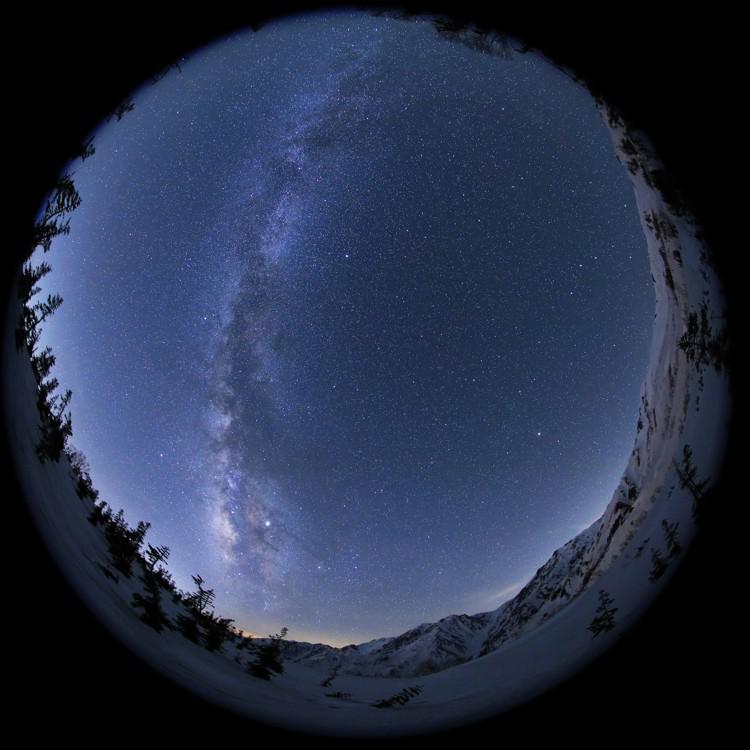This page describes an image The Milky Way Across the Zenith
Caption:
Winner in the 2022 IAU OAE Astrophotography Contest, category Still images of celestial patterns.
This all-sky image shows our home galaxy, the Milky Way, crossing the zenith, the point just above the observer as seen from Nagano, Japan, in May 2019. Such images of the whole sky can be taken either with a fish-eye lens or with a convex mirror on the ground, the latter of which would show the photographer as well.
Some of the brightest stars in the night sky can be seen in this image, as well as two of the giant planets of our Solar System: Jupiter, the brightest point in the bottom of this image, and Saturn, another bright point just to the opposite side of the Galaxy, to the bottom and next to the horizon.
Directly right of the Milky Way and below Jupiter, we can spot the bright red star Antares, the primary star of the Japanese asterism of The Heart. Japanese constellations derive from ancient Chinese constellations, which were adopted with only slight or no changes. In this tradition, The Heart is the heart of the “Azure Dragon”, a super-constellation that represents the spring. In the Babylonian and Greco-Roman traditions, this area is considered the heart of the Scorpion. In Babylonian religion, the star is associated with Lisi, the child of the mother goddess, but in Greek mythology it is related to the planet Mars, because of its colour. The reddish colour also led to the star’s Chinese name “The Fire Star”. We know that this colour is caused by its relatively cool temperature.
Going from Antares to the right of the image, we find the more northern parts of the sky. The bright star in the lower-right of the image, close to the horizon, is Arcturus, located in the modern constellation Boötes. While Antares and its surrounding area are considered the heart of the Azure Dragon, Arcturus and Spica (below the horizon) are two single-star asterisms forming its huge horn. Pointing towards it from above, at the right-hand edge of the image’s horizon, we can see the handle of the Big Dipper, or Plough, which is part of the constellation Ursa Major.
The bright point to the right of the galaxy and just above the middle of the image is Vega, located in the modern constellation Lyra. Extending a line to the other side of the Galaxy and a bit lower in the image we can find Altair, in the constellation Aquila. From that point we extend another line to Deneb, the brightest star in the constellation of the Swan, also a bit higher in this image and completely flooded by the Milky Way. These three bright stars comprise the asterism known as the Summer Triangle in the northern hemisphere.
Credit:
Ohnishi Kouji/IAU OAE
DOI: 10.5281/zenodo.7425196
Related glossary terms:
Jupiter
, Milky Way
, Saturn
, Scorpius
Categories:
Milky Way and Interstellar Medium
, Naked Eye Astronomy
License: Creative Commons Attribution 4.0 International (CC BY 4.0) Creative Commons Attribution 4.0 International (CC BY 4.0) icons
The media file captions presented on the OAE website were written, translated and reviewed by a collective effort from the OAE, the OAE Centers and Nodes, the OAE National Astronomy Education Coordinators (NAECs) and other volunteers. You can find a full list of credits for our translation project here. All media file captions are released under a Creative Commons CC BY-4.0 license and should be credited to "IAU OAE". The media files themselves may have different licenses (see above) and should be credited as listed above under "credit".
Captions in Different Languages:
Caption: Auszeichnung beim IAU OAE Astrofoto-Wettbewerb 2022, Kategorie Weitwinkelaufnahmen von Himmelsmustern.
Diese All-Sky-Aufnahme vom Mai 2019 zeigt unsere Heimatgalaxie, die Milchstraße, beim Überqueren des Zenits, also des Punkts direkt über dem Betrachter oder der Betrachterin in Nagano in Japan. Solche Bilder des gesamten Himmels können entweder mit einem Fischaugenobjektiv oder mit einem konvexen Spiegel auf dem Boden aufgenommen werden, wobei in letzterem Fall auch der Fotograf oder die Fotografin sichtbar wäre.
Einige der hellsten Sterne am Nachthimmel sind auf diesem Bild zu sehen, ebenso wie zwei der großen Gasplaneten unseres Sonnensystems: Jupiter, der hellste Punkt im unteren Teil des Bildes, und Saturn, ein weiterer heller Punkt auf der gegenüberliegenden Seite der Galaxis, ganz unten und in der Nähe des Horizonts.
Direkt rechts von der Milchstraße und unterhalb von Jupiter können wir den hellen rötlichen Stern Antares erkennen, den Hauptstern des japanischen Asterismus des Herzens. Japanische Sternbilder leiten sich von alten chinesischen Sternbildern ab, die mit nur geringen oder gar keinen Änderungen übernommen wurden. In dieser Tradition ist "Das Herz" das Herz des "Blauen Drachens", eines großen Sternbilds, das den Frühling darstellt. In der babylonischen und griechisch-römischen Tradition gilt dieser Bereich als das Herz des Skorpions. In der babylonischen Religion wird der Stern mit Lisi, dem Kind der Muttergöttin, in Verbindung gebracht, während er in der griechischen Mythologie aufgrund seiner Farbe mit dem Planeten Mars in Verbindung gebracht wird. Die rötliche Farbe hat dem Stern auch den chinesischen Namen "Feuerstern" eingebracht. Wir wissen, dass diese Farbe auf seine relativ kühle Temperatur zurückzuführen ist.
Wenn wir von Antares nach rechts im Bild gehen, finden wir die nördlicheren Teile des Himmels. Der helle Stern unten rechts im Bild, in der Nähe des Horizonts, ist Arktur, der sich im modernen Sternbild Bootes befindet. Während Antares und seine Umgebung als das Herz des Blauen Drachens gelten, sind Arktur und Spica (unter dem Horizont) zwei Einzelsterne, die sein riesiges Horn bilden. Wenn man von oben auf ihn zeigt, kann man am rechten Rand des Horizonts den Griff des Großen Wagens oder Pflugs sehen, der zum Sternbild der Großen Bärin (lat. Ursa Major) gehört.
Der helle Punkt rechts von der Milchstraße und knapp über der Bildmitte ist die Wega, die im modernen Sternbild Leier (lat. Lyra) liegt. Zieht man eine Linie nach links unten auf die andere Seite der Milchstraße, trifft man auf Altair im Sternbild Adler (lat. Aquila). Von diesem Punkt aus können wir eine weitere Linie zu Deneb ziehen, dem hellsten Stern im Sternbild Schwan, der ebenfalls etwas höher im Bild liegt und vollständig von der Milchstraße überflutet wird. Diese drei hellen Sterne bilden einen Asterismus, der auf der Nordhalbkugel als Sommerdreieck bekannt ist.
Credit: Ohnishi Kouji/IAU OAE
Related glossary terms: Jupiter , Milchstraße , Saturn , Skorpion Caption translation status: Not yet approved by a reviewer
Caption translators: Carolin Liefke
Caption: Gagnant du concours d'astrophotographie 2022 de l'UAI OAE, catégorie Images fixes de motifs célestes.
Cette image de l'ensemble du ciel montre notre galaxie, la Voie lactée, traversant le zénith, point situé juste au-dessus de l'observateur, vue de Nagano, au Japon, en mai 2019. De telles images de l'ensemble du ciel peuvent être prises soit avec un objectif fish-eye, soit avec un miroir convexe au sol, ce dernier montrant également le photographe.
Certaines des étoiles les plus brillantes du ciel nocturne sont visibles sur cette image, ainsi que deux des planètes géantes de notre système solaire : Jupiter, le point le plus brillant en bas de l'image, et Saturne, un autre point brillant juste à l'opposé de la galaxie, en bas et près de l'horizon.
Directement à droite de la Voie lactée et en dessous de Jupiter, nous pouvons apercevoir l'étoile rouge Antarès, étoile principale de l'astérisme japonais du Cœur. Les constellations japonaises dérivent des anciennes constellations chinoises, qui ont été adoptées avec peu ou pas de changements. Dans cette tradition, le Cœur est le cœur du "Dragon d'azur", une super-constellation qui représente le printemps. Dans les traditions babylonienne et gréco-romaine, cette zone est considérée comme le cœur du Scorpion. Dans la religion babylonienne, l'étoile est associée à Lisi, l'enfant de la déesse mère, mais dans la mythologie grecque, elle est liée à la planète Mars, en raison de sa couleur. La couleur rougeâtre est également à l'origine du nom chinois de l'étoile, "l'étoile de feu". Nous savons que cette couleur est due à sa température relativement froide.
En partant d'Antarès vers la droite de l'image, nous trouvons les parties les plus septentrionales du ciel. L'étoile brillante en bas à droite de l'image, près de l'horizon, est Arcturus, située dans la constellation moderne de la Boite à Bijoux. Alors qu'Antarès et ses environs sont considérés comme le cœur du dragon d'azur, Arcturus et Spica (sous l'horizon) sont deux astérismes mono-étoiles qui forment son énorme corne. En pointant vers elle depuis le haut, au bord droit de l'horizon de l'image, on peut voir l'anse de la Grande Ourse, ou chariot, qui fait partie de la constellation de la Grande Ourse.
Le point lumineux à droite de la galaxie et juste au-dessus du centre de l'image est Véga, située dans la constellation moderne de la Lyre. En prolongeant une ligne de l'autre côté de la galaxie et un peu plus bas sur l'image, nous trouvons Altaïr, dans la constellation de l'Aigle. De ce point, nous prolongeons une autre ligne jusqu'à Deneb, l'étoile la plus brillante de la constellation du Cygne, également un peu plus haut sur cette image et complètement noyée par la Voie Lactée. Ces trois étoiles brillantes constituent l'astérisme connu sous le nom de Triangle d'été dans l'hémisphère nord.
Credit: Ohnishi Kouji/UAI OAE
Related glossary terms: Jupiter , Milky Way , Saturn , Scorpius Caption translation status: Not yet approved by a reviewer
Caption translators: Gilles Remy
Caption: Vincitore del concorso di astrofotografia IAU OAE 2022, categoria Immagini fisse di modelli celesti.
Questa immagine a tutto cielo mostra la nostra galassia, la Via Lattea, che attraversa lo zenit, il punto appena sopra l'osservatore, vista da Nagano, in Giappone, nel maggio 2019. Queste immagini dell'intero cielo possono essere scattate con un obiettivo fish-eye o con uno specchio convesso a terra, che mostrerebbe anche il fotografo.
In questa immagine sono visibili alcune delle stelle più luminose del cielo notturno e due dei pianeti giganti del nostro Sistema Solare: Giove, il punto più luminoso nella parte inferiore di questa immagine, e Saturno, un altro punto luminoso proprio sul lato opposto della Galassia, in basso e vicino all'orizzonte.
Direttamente a destra della Via Lattea e sotto Giove, possiamo individuare la stella rossa brillante Antares, la stella primaria dell'asterismo giapponese del Cuore. Le costellazioni giapponesi derivano dalle antiche costellazioni cinesi, che sono state adottate con modifiche minime o nulle. In questa tradizione, Il Cuore è il cuore del "Drago Azzurro", una super-costellazione che rappresenta la primavera. Nelle tradizioni babilonese e greco-romana, questa zona è considerata il cuore dello Scorpione. Nella religione babilonese, la stella è associata a Lisi, il figlio della dea madre, ma nella mitologia greca è collegata al pianeta Marte, per via del suo colore. Il colore rossastro ha portato anche al nome cinese della "Stella di fuoco". Sappiamo che questo colore è dovuto alla sua temperatura relativamente fredda.
Passando da Antares alla destra dell'immagine, troviamo le zone più settentrionali del cielo. La stella luminosa in basso a destra dell'immagine, vicino all'orizzonte, è Arturo, situata nella moderna costellazione di Boote. Mentre Antares e l'area circostante sono considerati il cuore del Drago Azzurro, Arturo e Spica (sotto l'orizzonte) sono due asterismi a stella singola che formano il suo enorme corno. Puntando verso di esso dall'alto, al margine destro dell'orizzonte dell'immagine, possiamo vedere il manico del Grande Carro, che fa parte della costellazione dell'Orsa Maggiore.
Il punto luminoso a destra della galassia e appena sopra il centro dell'immagine è Vega, situata nella moderna costellazione della Lira. Estendendo una linea verso l'altro lato della galassia e un po' più in basso nell'immagine possiamo trovare Altair, nella costellazione dell'Aquila. Da questo punto si estende un'altra linea fino a Deneb, la stella più luminosa della costellazione del Cigno, anch'essa un po' più in alto nell'immagine e completamente sommersa dalla Via Lattea. Queste tre stelle luminose costituiscono l'asterismo noto come Triangolo estivo nell'emisfero settentrionale.
Credit: Ohnishi Kouji/IAU OAE
Related glossary terms: Giove , Saturno , Scorpione , Via Lattea Caption translation status: Approved by a reviewer
Caption translators: Giuliana Giobbi
Caption reviewers: Rodolfo Canestrari









